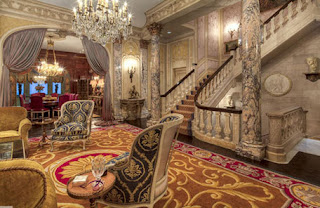Paradise Cove, that’s the name of the gated community where low income, and single parent families that makes $27.550 a year or less, can rents a nine-bedroom / six bathroom home with soaring ceilings, a gas-fueled fireplace and an oversize walk-in closet in the largest bedroom. The master bath even includes an enclosed toilet room, a feature popular in mini-mansions.
 |
| It's a scene from "The Jerk", But it works for this application |
"This is something you only see on TV," a future tenant says during a tour of the approximately 8,600-square-foot home. "I never thought I’d have anything like this." The development has a kidney-shaped swimming pool.
Their previous home in inner city was public housing, the woman says, and her six children were crammed into one bedroom. After her refrigerator caught fire, her landlord replaced it with an outdated brown model. She now has gleaming-white appliances.
This family can thank wealth re-distribrution. They participates in a government program for low-income families that subsidizes about two thirds her $6,400 monthly rent. The program, known as Section 8, has for decades put families in functional but basic homes and apartments, sometimes in less-than-desirable communities.
And, truth be known, many if not most of these people do not bother to pay their share of the rent. But the landlords are happy just to get the government money, and so allow them to continue to reside there. So this is often a ‘rent free’ situation for the tenant.
But overbuilding during the housing boom has left so many homes available that landlords, desperate for renters, are wooing Section 8 recipients, whose government subsidies are delivered electronically, guarantee the landlord gets paid. As a result, Section 8 recipients suddenly have a housing smorgasbord.
 |
| Housing Boom Surplus Homes |
But overbuilding during the housing boom has left so many homes available that landlords, desperate for renters, are wooing Section 8 recipients, whose government subsidies are delivered electronically, guarantee the landlord gets paid. As a result, Section 8 recipients suddenly have a housing smorgasbord.
Plenty of average housing stock remains in many places, but in certain markets, there are also more upscale selections. On the website GoSection8.com, landlords nationwide tout boom-era showpieces—replete with "great rooms," backyard swimming pools and built-in stainless-steel barbecue grills—that once sold for hundreds of thousands of dollars. Las Vegas has been one of the nation’s hardest-hit real-estate markets.
Some renters are getting pickier. Instead of accepting basic homes, they’re going for "another property that’s either bigger or in a better area or has more bedrooms. Before, they tended to take whatever they could get."
Some renters are getting pickier. Instead of accepting basic homes, they’re going for "another property that’s either bigger or in a better area or has more bedrooms. Before, they tended to take whatever they could get."
Though some neighbors have long contended that government-subsidized tenants increase crime and depress property values, some now say that having a house occupied is better than leaving it vacant, which attracts vandalism and other problems…
Racists. Still, I suspect that there is a lot of ‘vandalism,’ even when these houses are ‘occupied.’
Another section 8 recipient is looking for an apartment near Newport News, Va. Her current apartment in Philadelphia has a red brick dining-room floor and industrial-style windows. She longs for a dishwasher and a washer and dryer.
 |
| Future Section 8 Home |
Several rental listings around Newport News spotted on GoSection8.com have impressed her. One that stands out is a townhouse with a community weight room and a "theater area" with a big-screen TV for residents. Another perk: central air conditioning, which she now lacks. "I was like, ‘This can’t be Section 8 at all,"’ she says. "This is beautiful."
The change marks one of the most dramatic shifts since the 1974 creation of Section 8, nicknamed after its location in the U.S. Housing and Community Development Act.
Remember when ‘Section 8’ used to mean ‘crazy’? Some things never change.
The $18.1 billion Housing and Urban Development program offers more than 2 million families the chance to live outside of housing projects. Recipients pay a certain percentage of their income, typically no more than 30%, each month.
“Typically,” the "recipients" pay nothing at all these days.
Landlord participation is voluntary, and the home must pass an inspection. With no official centralized location for available properties, it is impossible to know how many units are available, though the count appears to be rising. When GoSection8.com was launched in 2004, a few hundred listings occurred monthly. Now, 700 or more can come daily, says Richard Cupelli, the site’s president. "The amount of new owners that are seeking Section 8 tenants is through the roof." …
 |
| Love Government Subsidies |
Last year, Mr. Davtyan, who rents to Section 8 tenants, paid $60,000 in cash for a four-bedroom house in North Las Vegas. He charges rent of $1,436 each month, giving him a profit of about $15,000 per year after insurance and property taxes, he says. He also paid $60,000 for a six-bedroom house in central Las Vegas 18 months ago that once commanded nearly $300,000. It rents for nearly $1,700 a month.
"It’s the most lucrative way to go right now," he says. "Nowhere else does your money make that kind of return."
And the beauty of this is that it is a self-generating program. Having ‘Section 8′ housing in the neighborhood means that the other houses will soon lose their value and be foreclosed upon. Which means more Section 8 housing. And the cycle continues.
It is more wealth redistribution, just by another means. It is ‘social justice’ at work.


No comments:
Post a Comment